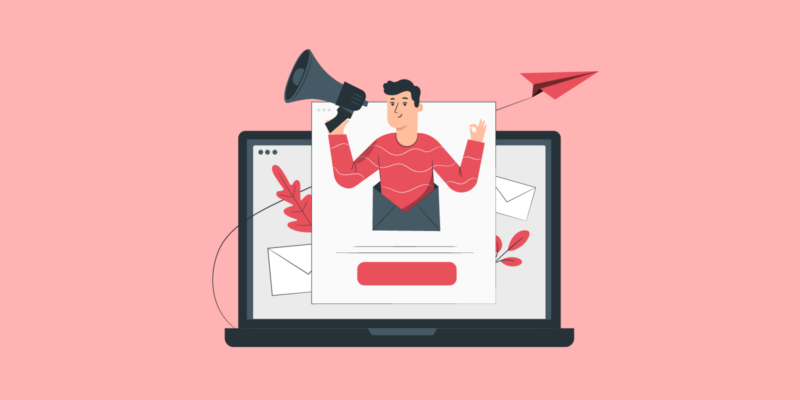If you’ve decided to join the eCommerce revolution and set up your very own eCommerce store, here comes the hard, but fun, part: you need to make sure your e-store stands apart from the competition and continues making sales throughout the whole year, not just during the major holidays.
Promoting and growing your eCommerce website can be a laborious task, especially if you don’t know where to start.
But this article will show you that it’s not that hard. There’s a number of tried and tested eCommerce marketing strategies that you can apply to your own business.
We’re sharing 16 email marketing tips that will help you optimize your eCommerce campaigns for higher clicks, opens, and engagement. Let’s get started.
In this article
Why Email Marketing?
Of course, email marketing is not the only way to approach eCommerce customers. You can also consider other options like social media, content marketing, SEO, SEM, or affiliate marketing. They are all effective, but if you had to choose only one marketing channel, we suggest email marketing.
Why? Because of the high ROI. According to the Data & Marketing Association, email generates nearly $40 in return for every one dollar spent. In addition, email continues to rank as the top digital marketing channel in terms of effectiveness. And the best part? It’s low cost. Once you’ve got permission from your contacts, you can continue running email campaigns without worrying about huge money investments.
How to Use eCommerce Email Marketing to Facilitate the Customers’ Journey
One of the biggest benefits of email marketing is that it works great across the entire customer lifecycle, from acquiring leads to converting them into customers, and even turning them into brand advocates!
How to Use Email Marketing for Customer Acquisition
If you want your eCommerce business to survive, you’ll need to find a way to continue attracting new customers.
Probably the best option is to use landing pages and email signup forms that ask your website visitors to join your email list. Once you have their email address, you can stay in touch by sending them updates about special promotions or offers. To convince prospects to sign up, offer something in return like a discount code, free delivery, receiving exclusive offers, etc.
Another option to consider is cold email outreach.
Despite what some of you might be thinking, cold emailing is still alive and kicking. Depending on the industry, average email open rates vary from about 15% to nearly 30%.
However, in order for cold emailing to be successful, it needs to be executed the right way. Getting people to open your cold emails isn’t easy – they don’t know your company or what it does, so why should they open your email? Using a powerful email outreach tool can be of great help, but you still need to write a perfect copy and make an irresistible offer in order to convince your leads to open and read your mail.
Here are a few tips that will help you pull it off:
- Let people know who you are. An email signature is a great way to introduce your brand and products in a non-intrusive way.
- Master your subject lines. 35% of recipients said they open emails based on the subject line alone.
- Test. A/B testing your subject line can boost open rates by nearly 50%.
- Make your cold emails personal. Including the recipient’s name in the subject line can increase your open rate by more than 20%.
- Keep it short. Nobody wants to spend their precious time reading a lengthy and detailed email from an unknown person or business.
How to Use Email Marketing for Conversion
Running promotional campaigns or blowout sales will only work for people who are ready to buy your products. As for the prospects that aren’t ready to give you their money yet, you can run lead nurturing campaigns.
Lead nurturing campaign is a series of emails that are sent on the basis of a lead’s behavior, with an aim to turn that lead into a buying customer. The goal of these campaigns is to build a relationship between your brand and your prospects by offering additional value.
Commonly, lead nurturing is used for:
- Customer onboarding campaigns, i.e. campaigns used to turn prospects into buyers;
- Re-engagement campaigns that aim to win-back leads who have made a purchase in the past or showed an intent to do so;
- Top of mind campaigns, i.e campaigns that aim to make your brand the first choice for people who are interested in your products but still aren’t ready to make a purchase.
If you’re planning to run lead nurturing campaigns, consider using a marketing automation tool to make the process much simpler and faster. A marketing automation tool will make it easy to send the right content, to the right contacts, at the right time.
How to Use Email Marketing for Retention
Repeat sales that lead to high CLV (customer lifetime value) and email campaigns are a great way to ensure you get these sales. That’s because email campaigns can be used in a number of ways to build brand loyalty and boost customer engagement.
You can use emails to retain your eCommerce customers in multiple ways. Some of the best examples include:
- Cart abandonment emails, which you can also use to ask potential customers for feedback on your site or the reason why they abandoned their cart.
- Post-purchase follow-up campaigns that are also great for strengthening customer loyalty, increasing product reviews, and offering best-selling products.
- Loyalty campaigns in which you will offer discounts for new products to existing customers.
5 eCommerce Email Campaigns You Must Try
The following 5 eCommerce email campaigns will help you strengthen the relationship with your customers and boost your sales.
1. Welcome Email
After people showed interest in your offer and joined your email list, it’s time to send them a kick-ass welcome email. Welcome emails usually have open rates between 50% and 60%, which makes them extremely important. A well-designed welcome mail will get people to visit your website and reinforce your brand, so make sure it delights your newly-acquired leads and turn them into customers ASAP.
2. Onboarding Campaign
Onboarding emails come soon after the welcome email. Their goal is to familiarize new recipients with your brand and the products you’re offering. The series of emails don’t need to be too long; they can contain 2-3 emails discussing the most important elements of your offer, like best-selling products or terms of delivery and returns.
3. Product Recommendation Email
You can send product recommendation emails to both email recipients who have already bought from you as well as to those who haven’t. In either case, the goal is to persuade them to take action. If they have already made a purchase, just recommend them the best products based on past searches and buying history. If they haven’t bought from you yet, recommend best-selling or best-rated products.
Product recommendation emails are very relevant which is what makes them successful.
4. Flash Sale Campaign
The goal of flash sale campaigns is to create a sense of urgency, make customers act, and generate revenue quickly.
For instance, you can do a blow-out sale campaign that lasts during the weekend or for 24 hours. Send a few reminders to the customers who haven’t opened the first email or those who engaged with the first email and visited your website but didn’t make a purchase.
However, you need to ensure you’re offering something truly valuable. Creating a fake sense of urgency can harm your brand’s image and cost you a lot of money in the long run.
5. Cart Abandonment Emails
We’ve already mentioned this type of emails but their importance should be stressed once more. Cart abandonment emails can have a big impact on your sales. The average open rate for cart abandonment emails is over 40%, with a CTR of nearly 30%.
They are sent to people who were very close to buying from you as a reminder, an incentive, or to be assured that your site is trustworthy and they’re getting a good deal.
8 Tips to Help You Create Great eCommerce Email Campaigns
1. Pay Attention to Your Content
How do you know what type of content will work best for your target audience? Do they prefer written content or videos? Maybe you should send user-generated content? The best way to figure this out is by testing different types of email content and analyzing your results but in general, people process visuals 60,000 faster than text.
If they’re given a choice, most of your customers would probably prefer watching to reading. This is especially true for eCommerce where your target is to make customers click through your website.
2. The Words You Use Can Make a Big Difference
Even though eCommerce email campaigns are usually focused on flashy design and high-quality images, the copy is no less important.
We’ve already mentioned that the subject line is a very important element, so you should pay special attention to it. You should also work on the preheader, header, and your CTAs. Use power words to urge people to take action, reinforce your message, and help you convert recipients into buying customers.
3. Segment Your Audience
Marketers should be aware that not all customers are the same. For instance, there can be high spenders, trendsetters, or customers with high average order value.
How you communicate in your email campaigns should be based on who you’re targeting. Which segment needs a discount code to be persuaded to buy your new product? For whom is it important to be among the first to get that new product? Ask yourself these questions before your next campaign.
4. Personalize Your Campaigns
Sending generic email campaigns that aren’t aimed at anyone specific isn’t going to do the trick. Email marketing statistics say that when both the subject and the message are personalized, emails have an average open rate of nearly 6% and a CTR of 2%. This means that you need to go beyond the subject line and ensure that the content and tone you use are relevant to your target audience.
5. Pay Attention to Mailing Frequency
When it comes to emailing frequency, be careful not to get tempted to send an extra email every now and then. It may seem harmless but sending emails too often can really annoy your audience. In fact, receiving too many emails is the number one reason why subscribers opt out of email campaigns. So, be sure to analyze the data carefully before you decide to increase the mailing frequency,
6. Use Social Proof
Why not turn customers into brand advocates? Customer testimonials, opinions, and reviews are some of the most valuable pieces of marketing you have. Think about it: you can have the best products on the market or outstanding customer service, but what’s it worth if you can’t prove it?
7. Focus on All Devices
When designing your landing pages, ad campaigns, and email campaigns, think about all the devices your customers may be using. Pay attention to different elements like image size, CTA buttons placement, the check out process, the appearance of product pages, etc. You need to make sure that the experience is as smooth and as seamless as possible. If only one of these elements isn’t working properly on mobile devices, you might be wasting both your money and your customers’ interest.
8. Never Stop Optimizing
When it comes to what’s working best, your hunch may be right, but try to forget about your ego for a moment. Instead of going for things that you’re familiar with and comfortable with, rely on data to create A/B tests and optimize your email campaigns.
In addition, when optimizing your email campaigns, remember that your customers are the key element. Ask them for their feedback in order to learn more about what they want. Survey emails are a great way to get to know them better, overcome their fears, and improve your email campaigns. Show them that you genuinely care and value their opinions.
Final Thoughts
There you have it. This is all you need to know about getting started with eCommerce email marketing. Now, you only need to decide what your first step is going to be.



